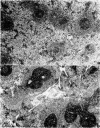Abstract
Cell-mediated immune reactions, such as allogenic skin-graft rejection and PHA or MLC responses, and antibody synthesis against different antigens (sheep erythrocytes, Brucella antigen, bovine serum albumin) have been evaluated in rats suffering from experimentally-induced diabetes and in age-matched sham-treated controls. Cell-mediated immune reactions are strongly depressed diabetic rats. The cellularity of the thymus and of thymus-dependent areas and the number of peripheral blood lymphocytes is significantly reduced in pancreatectomized rats. Moreover, the immunological recovery from heavy cortisonization is also greatly impaired. Daily treatment with insulin may prevent these immunological alterations. By contrast, antibody responses in diabetic rats are not quantitatively altered in respect to either the number of antibody producing cells in the spleen or the circulating antibody titres. The discrepancy between the abnormality of cell-mediated immune reactions in diabetic rats and their physiological capacity to synthetize antibodies suggests that the sensitivity to an insulin-deprived environment is present only in a definite, although yet undefined, subpopulation of lymphoid cells rather than in the whole lymphoid system.
Full text
PDF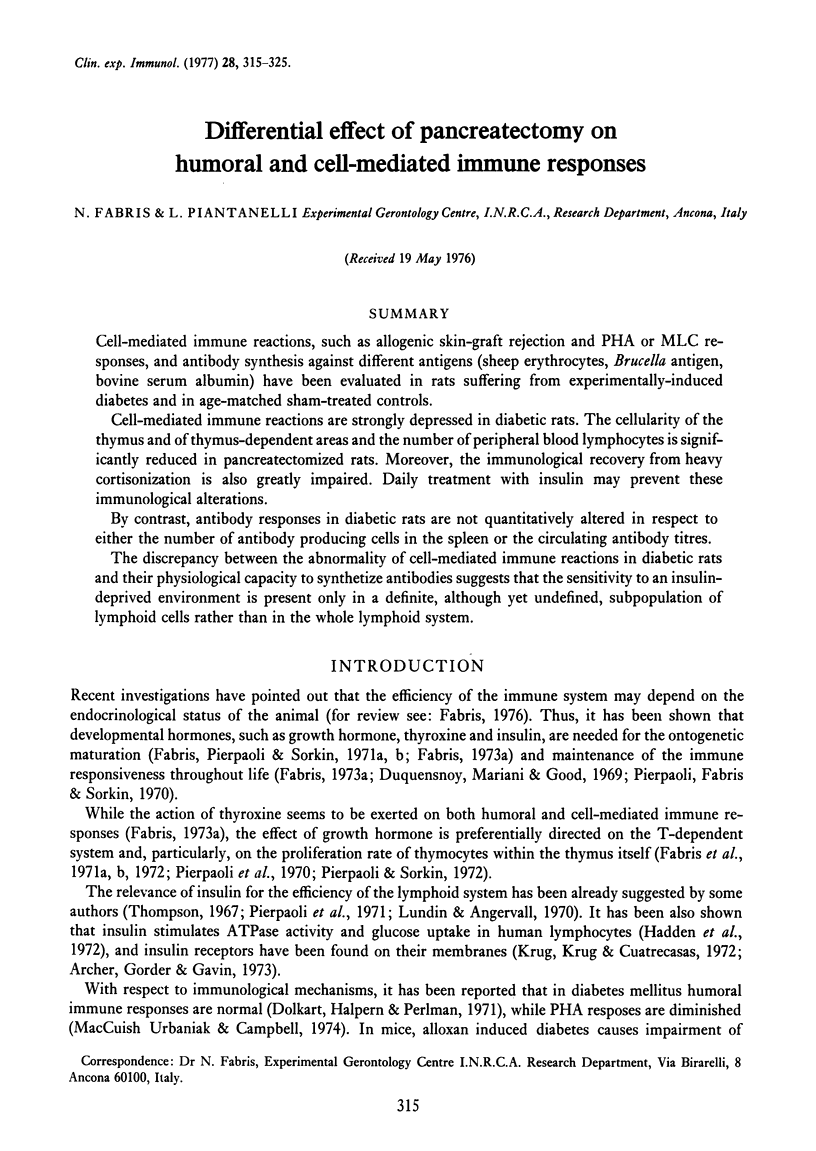
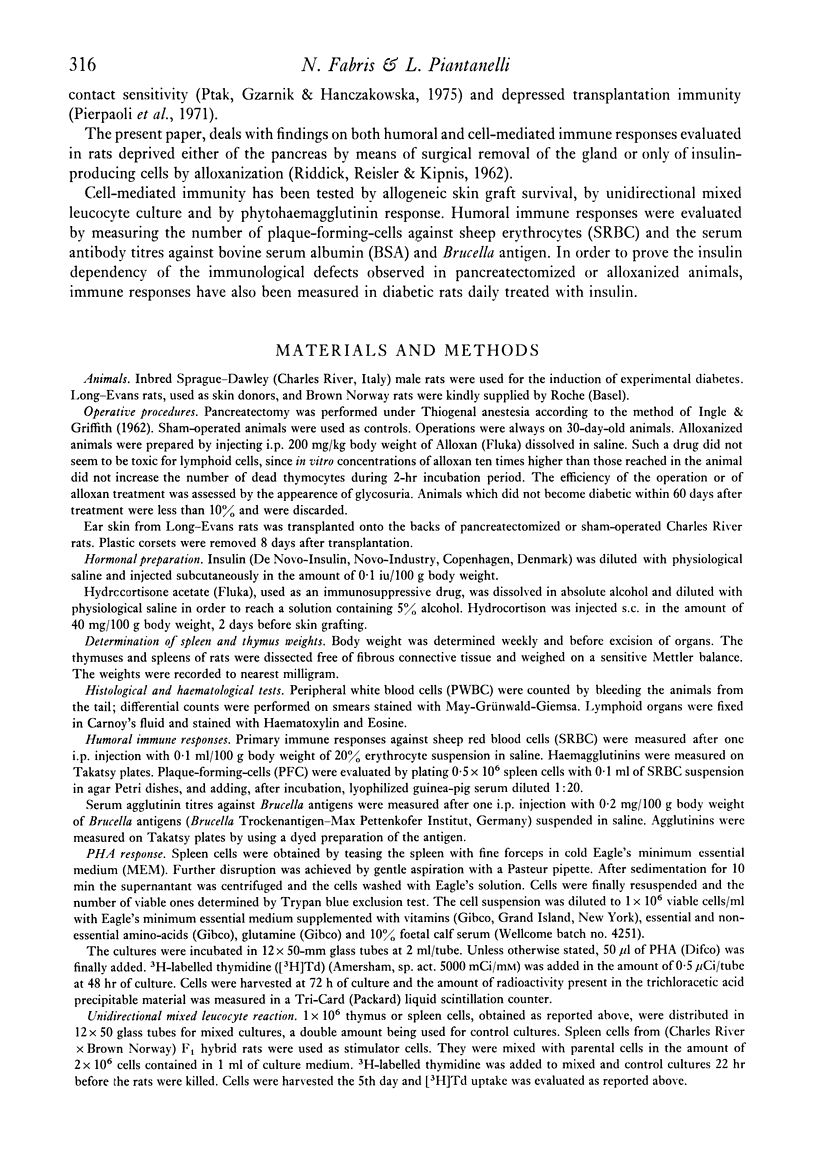

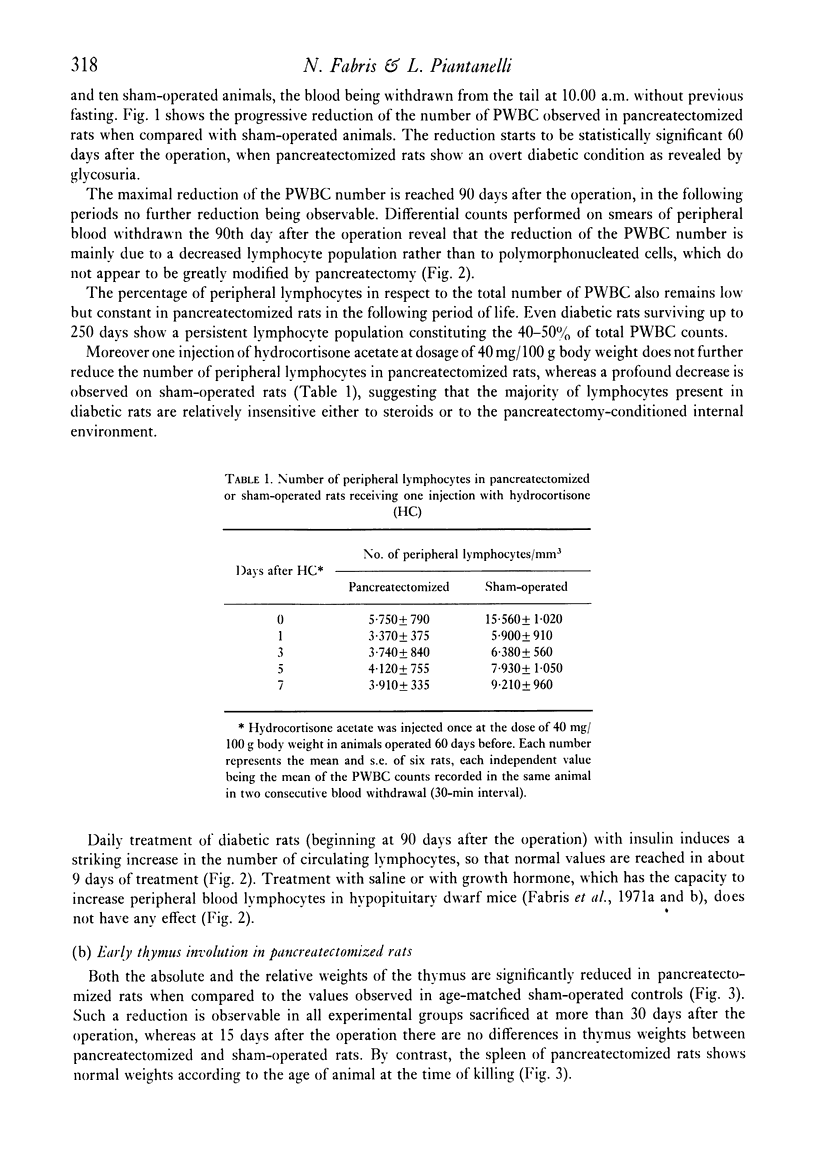



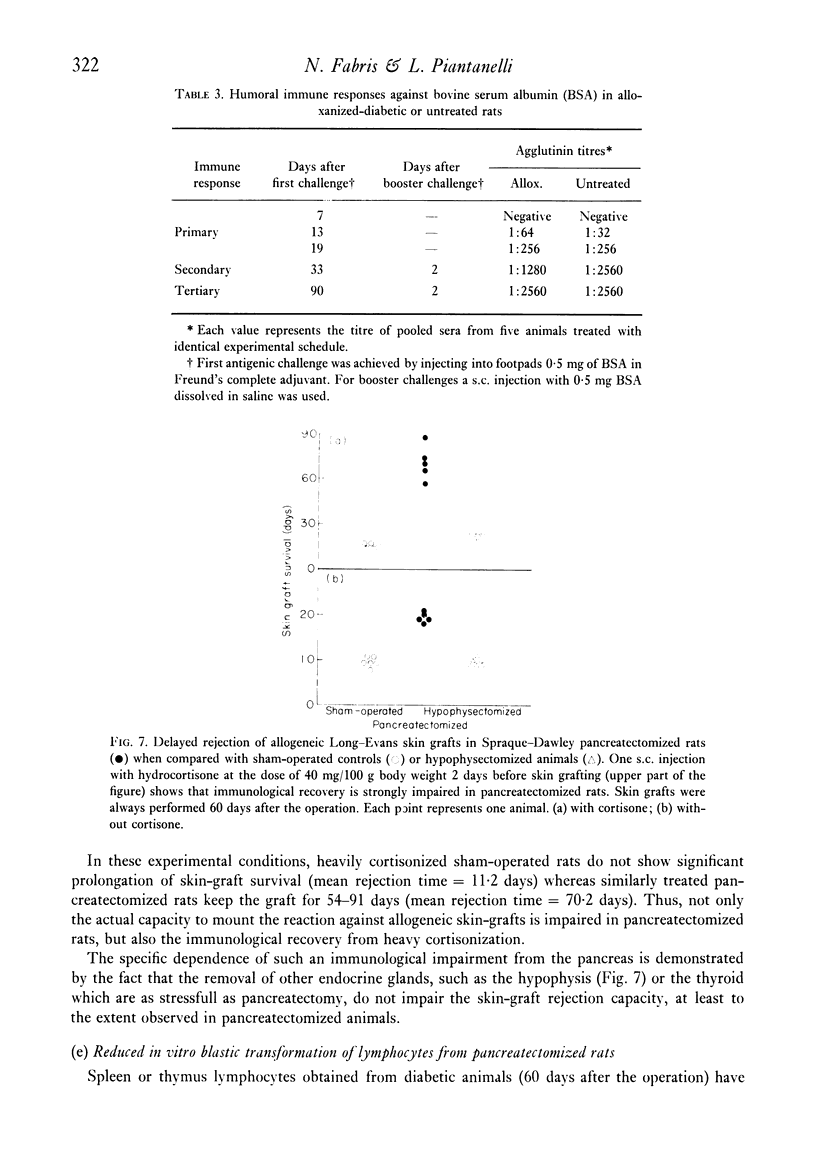

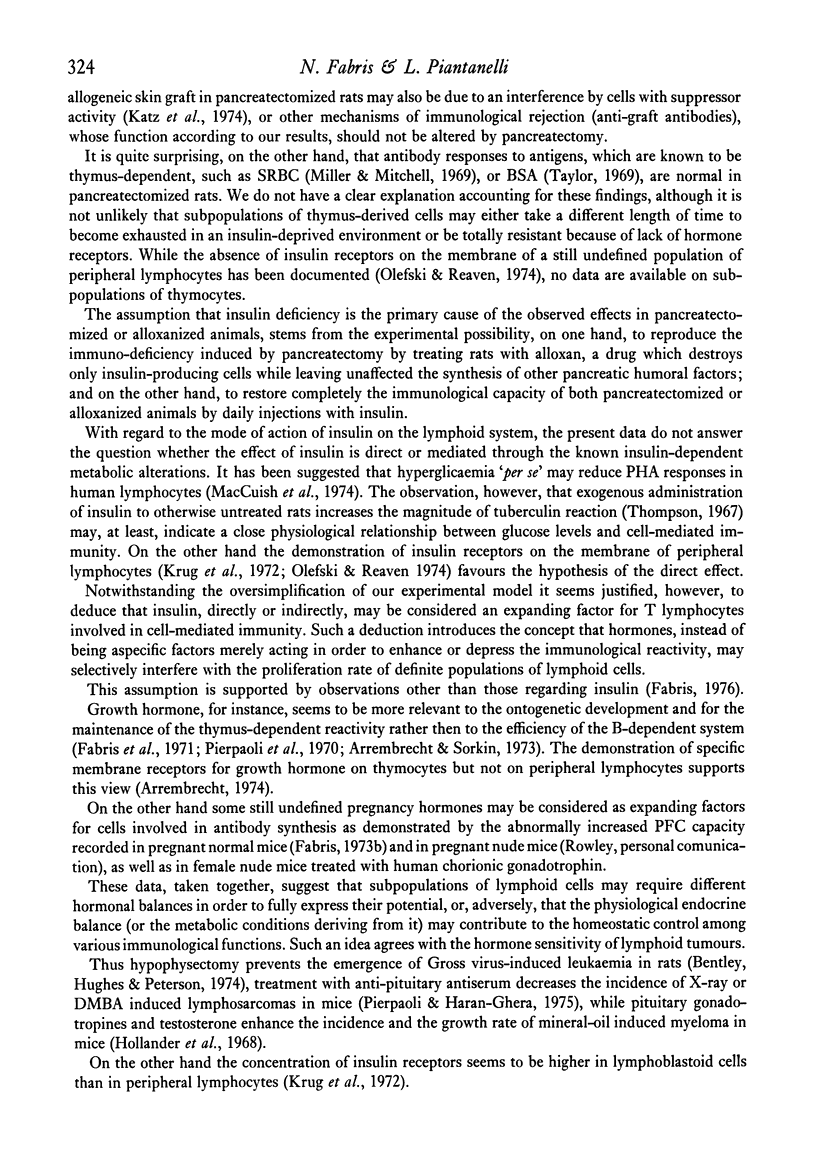
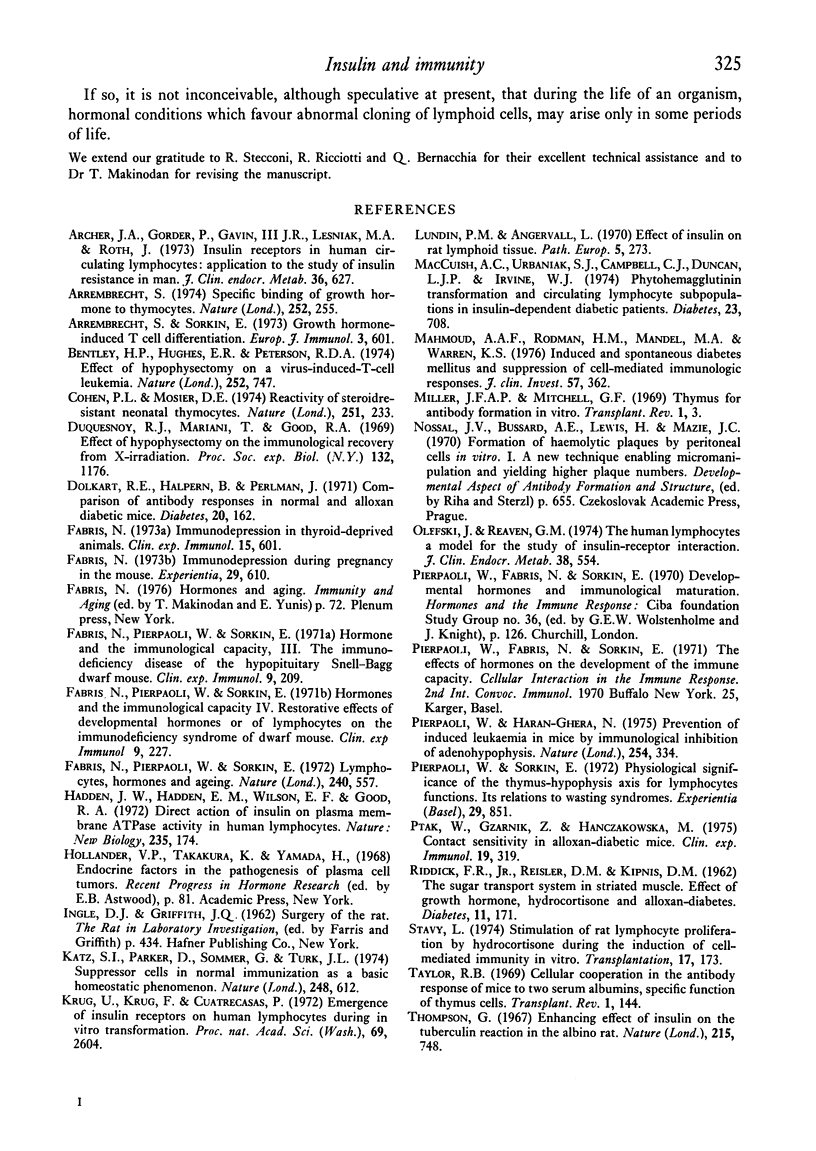
Images in this article
Selected References
These references are in PubMed. This may not be the complete list of references from this article.
- Archer J. A., Gorden P., Gavin J. R., 3rd, Lesniak M. A., Roth J. Insulin receptors in human circulating lymphocytes: application to the study of insulin resistance in man. J Clin Endocrinol Metab. 1973 Apr;36(4):627–633. doi: 10.1210/jcem-36-4-627. [DOI] [PubMed] [Google Scholar]
- Arrenbrecht S., Sorkin E. Growth hormone-induced T cell differentiation. Eur J Immunol. 1973 Sep;3(9):601–604. doi: 10.1002/eji.1830030915. [DOI] [PubMed] [Google Scholar]
- Arrenbrecht S. Specific binding of growth hormone to thymocytes. Nature. 1974 Nov 15;252(5480):255–257. doi: 10.1038/252255a0. [DOI] [PubMed] [Google Scholar]
- Bentley H. P., Hughs E. R., Peterson R. D. Effect of hypophysectomy on a virus-induced T-cell leukemia. Nature. 1974 Dec 20;252(5485):747–748. doi: 10.1038/252747a0. [DOI] [PubMed] [Google Scholar]
- Cohen P. L., Mosier D. E. Reactivity of steroid-resistant neonatal thymocytes. Nature. 1974 Sep 20;251(5472):233–234. doi: 10.1038/251233a0. [DOI] [PubMed] [Google Scholar]
- Duquesnoy R. J., Mariani T., Good R. A. Effect of hypophysectomy on immunological recovery after sublethal irradiation of adult rats. Proc Soc Exp Biol Med. 1969 Sep;131(4):1176–1178. doi: 10.3181/00379727-131-34064. [DOI] [PubMed] [Google Scholar]
- Fabris N. Immunodepression in thyroid-deprived animals. Clin Exp Immunol. 1973 Dec;15(4):601–611. [PMC free article] [PubMed] [Google Scholar]
- Fabris N. Immunological reactivity during pregnancy in the mouse. Experientia. 1973 May 15;29(5):610–612. doi: 10.1007/BF01926697. [DOI] [PubMed] [Google Scholar]
- Fabris N., Pierpaoli W., Sorkin E. Hormones and the immunological capacity. 3. The immunodeficiency disease of the hypopituitary Snell-Bagg dwarf mouse. Clin Exp Immunol. 1971 Aug;9(2):209–225. [PMC free article] [PubMed] [Google Scholar]
- Fabris N., Pierpaoli W., Sorkin E. Hormones and the immunological capacity. IV. Restorative effects of developmental hormones or of lymphocytes on the immunodeficiency syndrome of the dwarf mouse. Clin Exp Immunol. 1971 Aug;9(2):227–240. [PMC free article] [PubMed] [Google Scholar]
- Fabris N., Pierpaoli W., Sorkin E. Lymphocytes, hormones and ageing. Nature. 1972 Dec 29;240(5383):557–559. doi: 10.1038/240557a0. [DOI] [PubMed] [Google Scholar]
- Hadden J. W., Hadden E. M., Wilson E. E., Good R. A., Coffey R. G. Direct action of insulin on plasma membrane ATPase activity in human lymphocytes. Nat New Biol. 1972 Feb 9;235(58):174–177. doi: 10.1038/newbio235174a0. [DOI] [PubMed] [Google Scholar]
- Katz S. I., Parker D., Sommer G., Turk J. L. Suppressor cells in normal immunisation as a basic homeostatic phenomenon. Nature. 1974 Apr 12;248(449):612–614. doi: 10.1038/248612a0. [DOI] [PubMed] [Google Scholar]
- Krug U., Krug F., Cuatrecasas P. Emergence of insulin receptors on human lymphocytes during in vitro transformation. Proc Natl Acad Sci U S A. 1972 Sep;69(9):2604–2608. doi: 10.1073/pnas.69.9.2604. [DOI] [PMC free article] [PubMed] [Google Scholar]
- Lundin P. M., Angervall L. Effect of insulin on rat lymphoid tissue. Pathol Eur. 1970;5(3):273–278. [PubMed] [Google Scholar]
- MacCuish A. C., Urbaniak S. J., Campbell C. J., Duncan L. J., Irvine W. J. Phytohemagglutinin transformation and circulating lymphocyte subpopulations in insulin-dependent diabetic patients. Diabetes. 1974 Aug;23(8):708–712. doi: 10.2337/diab.23.8.708. [DOI] [PubMed] [Google Scholar]
- Mahmoud A. A., Rodman H. M., Mandel M. A., Warren K. S. Induced and spontaneous diabetes mellitus and suppression of cell-mediated immunologic responses. Granuloma formation, delayed dermal reactivity and allograft rejection. J Clin Invest. 1976 Feb;57(2):362–367. doi: 10.1172/JCI108287. [DOI] [PMC free article] [PubMed] [Google Scholar]
- Miller J. F., Mitchell G. F. Thymus and antigen-reactive cells. Transplant Rev. 1969;1:3–42. doi: 10.1111/j.1600-065x.1969.tb00135.x. [DOI] [PubMed] [Google Scholar]
- Olefsky J., Reaven G. M. The human lymphocyte: a model for the study of insulin-receptor interaction. J Clin Endocrinol Metab. 1974 Apr;38(4):554–560. doi: 10.1210/jcem-38-4-554. [DOI] [PubMed] [Google Scholar]
- Pierpaoli W., Fabris N., Sorkin E. Developmental hormones and immunological maturation. Ciba Found Study Group. 1970;36:126–153. [PubMed] [Google Scholar]
- Pierpaoli W., Haran-Ghera N. Prevention of induced leukaemia in mice by immunological inhibition of adenohypophysis. Nature. 1975 Mar 27;254(5498):334–335. doi: 10.1038/254334a0. [DOI] [PubMed] [Google Scholar]
- Pierpaoli W., Sorkin E. A thymus dependent function of the adrenal cortex and its relation to immunity. Experientia. 1972 Jul 15;28(7):851–852. doi: 10.1007/BF01923171. [DOI] [PubMed] [Google Scholar]
- Ptak W., Czarnik Z., Hanczakowska M. Contact sensitivity in alloxan-diabetic mice. Clin Exp Immunol. 1975 Feb;19(2):319–325. [PMC free article] [PubMed] [Google Scholar]
- RIDDICK F. A., Jr, REISLER D. M., KIPNIS D. M. The sugar transport system in striated muscle. Effect of growth hormone, hydrocortisone and alloxan diabetes. Diabetes. 1962 May-Jun;11:171–178. [PubMed] [Google Scholar]
- Stavy L., Cohen I. R., Feldman M. Stimulation of rat lymphocyte proliferation by hydrocortisone during the induction of cell-mediated immunity in vitro. Transplantation. 1974 Feb;17(2):173–179. doi: 10.1097/00007890-197402000-00004. [DOI] [PubMed] [Google Scholar]
- Thompson G. E. Enhancing effect of insulin on the tuberculin reaction in the albino rat. Nature. 1967 Aug 12;215(5102):748–749. doi: 10.1038/215748a0. [DOI] [PubMed] [Google Scholar]



